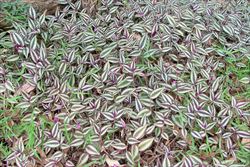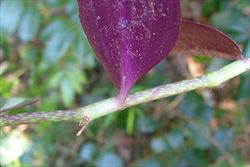Click on images to enlarge

infestation (Photo: Sheldon Navie)

infestation (Photo: Sheldon Navie)

habit (Photo: Sheldon Navie)

habit in flower (Photo: Sheldon Navie)

young stem with purplish markings and adventitious roots beginning to develop (Photo: Sheldon Navie)

variegated leaves (Photo: Sheldon Navie)

close-up of leaves with silvery markings and purplish margins (Photo: Sheldon Navie)

close-up of purplish leaf undersides and leaf sheaths (Photo: Sheldon Navie)

close-up of flower with three rounded pink petals (Photo: Sheldon Navie)
Scientific Name
Tradescantia zebrina hort. ex Bosse
Synonyms
Tradescantia pendula (Schnizl.) D.R. HuntZebrina pendula Schnizl.
Family
Commelinaceae
Common Names
cockroach grass, inch plant, inchplant, purple wandering Jew, silver inch plant, silvery inch plant, striped trad, striped wandering creeper, striped wandering Jew, wandering Jew, wandering zebrina, wandering-Jew, zebra plant, zebrina
Origin
Native to Mexico.
Cultivation
Cultivated as a garden ornamental, particularly in the warmer parts of Australia. It is often grown as a groundcover, mainly for its colourful foliage.
Naturalised Distribution
Widely naturalised in the coastal districts of eastern Australia (i.e. in eastern Queensland and the coastal districts of northern and central New South Wales). Also naturalised on Lord Howe Island and possibly naturalised on Norfolk Island.
Naturalised overseas in south-eastern USA (i.e. Louisiana, Florida and Kentucky) and on several Pacific islands (i.e. the Cook Islands, the Galápagos Islands, Fiji, French Polynesia, New Caledonia, Niue, Palau, Western Samoa, Tonga and Hawaii).
Habitat
A weed of waste areas, disturbed sites, roadsides, urban bushland, riparian vegetation, open woodlands and forests in sub-tropical and warmer temperate regions.
Habit
A long-lived (i.e. perennial) herbaceous plant with weak, trailing or creeping, stems.
Distinguishing Features
- a succulent trailing herbaceous plant.
- its distinctively coloured leaves are silvery green flushed with purple on the upper surface and purple underneath.
- these leaves have bases that sheath the stems.
- its bright pink flowers have three petals.
Stems and Leaves
The stems readily produce roots (i.e. adventitious roots) at their joints (i.e. nodes). These fleshy (i.e. succulent) branching stems are hairless (i.e. glabrous) and usually tinged with purplish-red.
The leaves consist of a short leaf sheath (7-10 mm long), which encloses the stem, and a spreading leaf blade. The leaf blades (3-7 cm long and 1.5 -3 cm wide) are egg-shaped in outline (i.e. ovate) or broadly lance-shaped (i.e. lanceolate) with entire margins and narrow to a point at the tip (i.e. acute or acuminate apex). They are green and/or purplish with broad silvery stripes on the upper surface and darker purple on the undersides. The leaf sheaths are hairy (i.e. ciliate) along their margins and the leaf blades are hairless (i.e. glabrous).
Flowers and Fruit
The flowers are borne in small clusters at the tips of the stems, and are subtended by two leafy bracts. They have three bright pink or purple-magenta petals (10-12 mm long) that are fused at the base into a whitish tube 5-9 mm long with three rounded spreading lobes (about 6 mm long). They also have three smaller sepals and three stamens bearded with purplish hairs. Flowering occurs mainly in spring and summer.
The fruit are small capsules containing greyish-brown seeds.
Reproduction and Dispersal
This plant reproduces by seed and also vegetatively via its creeping stems that produce roots at their joints (i.e. stolons).
Stem fragments easily break off and may be dispersed by water, vehicles, machinery, in dumped garden waste or in contaminated soil.
Environmental Impact
Zebrina (Tradescantia zebrina) is regarded as an environmental weed in Queensland and New South Wales.
Legislation
Not declared or considered noxious by any state government authorities.
Management
For information on the management of this species see the following resources:
- the Biosecurity Queensland Fact Sheet on this species, which is available online at http://www.dpi.qld.gov.au.
Similar Species
Zebrina (Tradescantia zebrina) is relatively similar to trad (Tradescantia fluminensis), native wandering Jew (Commelina diffusa) and hairy wandering Jew (Commelina benghalensis). These species can be distinguished by the following differences:
- zebrina (Tradescantia zebrina) has variegated purplish leaves that are hairless and somewhat fleshy. Its flowers are bright pink with rounded petals.
- trad (Tradescantia albiflora) has glossy green leaves that are mostly hairless and somewhat fleshy. Its flowers are white with three pointed petals.
- native wandering Jew (Commelina diffusa) has dull green leaves that are hairless and relatively thin. Its flowers are usually bright blue (rarely white) with rounded petals.
- hairy wandering Jew (Commelina benghalensis) has dull green leaves that are hairy and relatively thin. Its flowers are usually bright blue with rounded petals.

